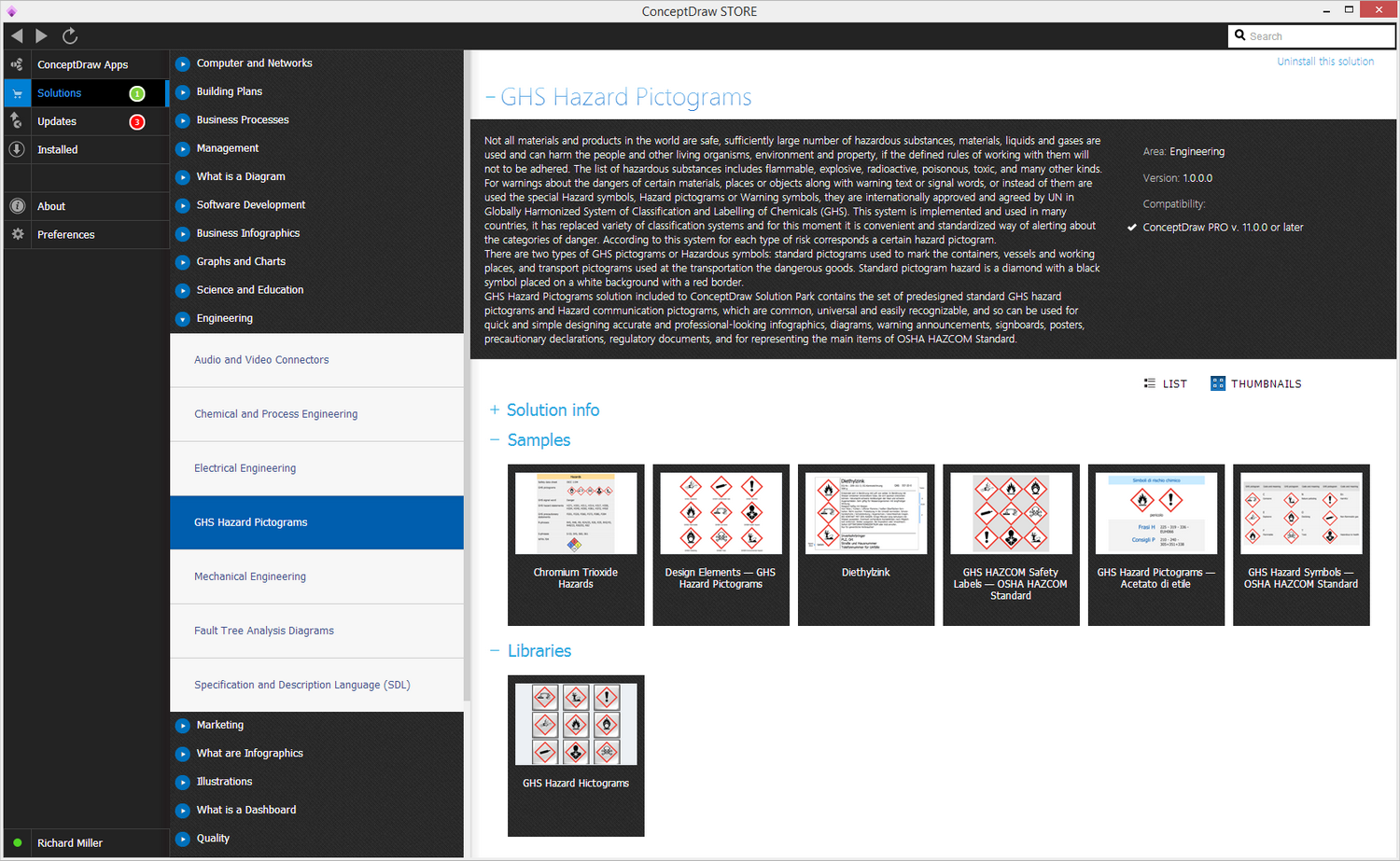- Electric and Telecom Plans Free
- Fire and Emergency Plans Free
- Floor Plans Free
- Plant Layout Plans Free
- School and Training Plans Free
- Seating Plans Free
- Security and Access Plans Free
- Site Plans Free
- Sport Field Plans Free
- Business Process Diagrams Free
- Business Process Mapping Free
- Classic Business Process Modeling Free
- Cross-Functional Flowcharts Free
- Event-driven Process Chain Diagrams Free
- IDEF Business Process Diagrams Free
- Logistics Flow Charts Free
- Workflow Diagrams Free
- ConceptDraw Dashboard for Facebook Free
- Mind Map Exchange Free
- MindTweet Free
- Note Exchange Free
- Project Exchange Free
- Social Media Response Free
- Active Directory Diagrams Free
- AWS Architecture Diagrams Free
- Azure Architecture Free
- Cisco Network Diagrams Free
- Cisco Networking Free
- Cloud Computing Diagrams Free
- Computer Network Diagrams Free
- Google Cloud Platform Free
- Interactive Voice Response Diagrams Free
- Network Layout Floor Plans Free
- Network Security Diagrams Free
- Rack Diagrams Free
- Telecommunication Network Diagrams Free
- Vehicular Networking Free
- Wireless Networks Free
- Comparison Dashboard Free
- Composition Dashboard Free
- Correlation Dashboard Free
- Frequency Distribution Dashboard Free
- Meter Dashboard Free
- Spatial Dashboard Free
- Status Dashboard Free
- Time Series Dashboard Free
- Basic Circle-Spoke Diagrams Free
- Basic Circular Arrows Diagrams Free
- Basic Venn Diagrams Free
- Block Diagrams Free
- Concept Maps Free
- Family Tree Free
- Flowcharts Free
- Basic Area Charts Free
- Basic Bar Graphs Free
- Basic Divided Bar Diagrams Free
- Basic Histograms Free
- Basic Line Graphs Free
- Basic Picture Graphs Free
- Basic Pie Charts Free
- Basic Scatter Diagrams Free
- Aerospace and Transport Free
- Artwork Free
- Audio, Video, Media Free
- Business and Finance Free
- Computers and Communications Free
- Holiday Free
- Manufacturing and Maintenance Free
- Nature Free
- People Free
- Presentation Clipart Free
- Safety and Security Free
- Analog Electronics Free
- Audio and Video Connectors Free
- Basic Circuit Diagrams Free
- Chemical and Process Engineering Free
- Digital Electronics Free
- Electrical Engineering Free
- Electron Tube Circuits Free
- Electronic Block Diagrams Free
- Fault Tree Analysis Diagrams Free
- GHS Hazard Pictograms Free
- Home Automation and Wiring Free
- Mechanical Engineering Free
- One-line Diagrams Free
- Power Сircuits Free
- Specification and Description Language (SDL) Free
- Telecom and AV Circuits Free
- Transport Hazard Pictograms Free
- Data-driven Infographics Free
- Pictorial Infographics Free
- Spatial Infographics Free
- Typography Infographics Free
- Calendars Free
- Decision Making Free
- Enterprise Architecture Diagrams Free
- Fishbone Diagrams Free
- Organizational Charts Free
- Plan-Do-Check-Act (PDCA) Free
- Seven Management and Planning Tools Free
- SWOT and TOWS Matrix Diagrams Free
- Timeline Diagrams Free
- Australia Map Free
- Continent Maps Free
- Directional Maps Free
- Germany Map Free
- Metro Map Free
- UK Map Free
- USA Maps Free
- Customer Journey Mapping Free
- Marketing Diagrams Free
- Matrices Free
- Pyramid Diagrams Free
- Sales Dashboard Free
- Sales Flowcharts Free
- Target and Circular Diagrams Free
- Cash Flow Reports Free
- Current Activities Reports Free
- Custom Excel Report Free
- Knowledge Reports Free
- MINDMAP Reports Free
- Overview Reports Free
- PM Agile Free
- PM Dashboards Free
- PM Docs Free
- PM Easy Free
- PM Meetings Free
- PM Personal Time Management Free
- PM Planning Free
- PM Presentations Free
- PM Response Free
- Resource Usage Reports Free
- Visual Reports Free
- House of Quality Free
- Quality Mind Map Free
- Total Quality Management TQM Diagrams Free
- Value Stream Mapping Free
- Astronomy Free
- Biology Free
- Chemistry Free
- Language Learning Free
- Mathematics Free
- Physics Free
- Piano Sheet Music Free
- Android User Interface Free
- Class Hierarchy Tree Free
- Data Flow Diagrams (DFD) Free
- DOM Tree Free
- Entity-Relationship Diagram (ERD) Free
- EXPRESS-G data Modeling Diagram Free
- IDEF0 Diagrams Free
- iPhone User Interface Free
- Jackson Structured Programming (JSP) Diagrams Free
- macOS User Interface Free
- Object-Role Modeling (ORM) Diagrams Free
- Rapid UML Free
- SYSML Free
- Website Wireframe Free
- Windows 10 User Interface Free
GHS Hazard Pictograms
Not all materials and products in the world are safe, sufficiently large number of hazardous substances, materials, liquids, and gases are used that can harm people and other living organisms, the environment and property, if certain rules of working with them are not adhered. The list of hazardous substances includes flammable, explosive, radioactive, poisonous, toxic, and many other kinds. For hazard warnings of certain materials, places or objects, along with or in place of warning text or signal words, special hazard symbols, hazard pictograms or warning symbols are used, they are internationally approved and agreed by the UN in the Globally Harmonized System of Classification and Labeling of Chemicals (GHS). This system is implemented and used in many countries, it has replaced many classification systems, and at the moment it is a convenient and standardized way of warning about hazard categories. According to this system for each type of risk corresponds a certain hazard pictogram.
There are two types of GHS pictograms or Hazardous symbols: standard pictograms are used to mark the containers, vessels and working places, and transport pictograms are used for transporting of dangerous goods.Standard pictogram hazard is a diamond with a black symbol placed on a white background with a red border.
GHS Hazard Pictograms solution included to ConceptDraw Solution Park contains a set of predesigned standard GHS hazard pictograms and Hazard communication pictograms, which are common, universal and easily recognizable, and so can be used for quick and simple designing accurate and professional-looking infographics, diagrams, warning announcements, signboards, posters, precautionary declarations, regulatory documents, and for representing the main items of OSHA HAZCOM Standard.
-
Install this solution Free -
What I need to get started -
Solution Requirements - This solution requires the following products to be installed:
ConceptDraw DIAGRAM v17 - This solution requires the following products to be installed:
-
Compatibility - Monterey (12), Ventura (13), Sonoma (14)
MS Windows 8.1, 10 - Monterey (12), Ventura (13), Sonoma (14)
-
Support for this Solution -
Helpdesk
There is 1 library containing 9 vector shapes in the GHS Hazard Pictograms solution.
Design Elements — GHS Hazard Pictograms

Related News:
Examples
On this page, you see some examples that were created in the ConceptDraw DIAGRAM application using the GHS Hazard Pictograms solution. Some of the solution features as well as the professional results you can achieve are all demonstrated here on this page.
All source documents are vector graphic documents which are always available for modifying, reviewing and/or converting to many different formats, such as MS PowerPoint, PDF file, MS Visio, and many other graphic files from the ConceptDraw Solution Park or ConceptDraw STORE. The GHS Hazard Pictograms solution is available to all ConceptDraw DIAGRAM users to get installed and used while working in the ConceptDraw DIAGRAM diagramming and drawing software.
Example 1: GHS Hazard Symbols — OSHA HAZCOM Standard
This diagram was created in ConceptDraw DIAGRAM using the GHS Hazard Pictograms library from the GHS Hazard Pictograms Solution. An experienced user spent 5 minutes creating this sample.
This chemical safety infographic sample shows a table of GHS hazard pictograms, their codes and meanings. It was designed based on the table from the Wikimedia Commons article "GHS hazard symbols". All the GHS pictograms you see are vector and taken from the GHS Hazard Pictograms library offered by the GHS Hazard Pictograms solution. They are widespread and easily recognizable symbols used to warn about hazardous materials, hazardous substances, dangerous objects or locations. The hazard symbols are recognized faster than reading the written warnings. Presenting the symbols along with their names or a brief description allows you to inform the audience of all available standardized characters in order to simplify the choice of which is best suited to the particular case. These hazard symbols are made in the same style, have the diamond shape with internal borders traced by red color. Such symbols are drawn by black on white background.
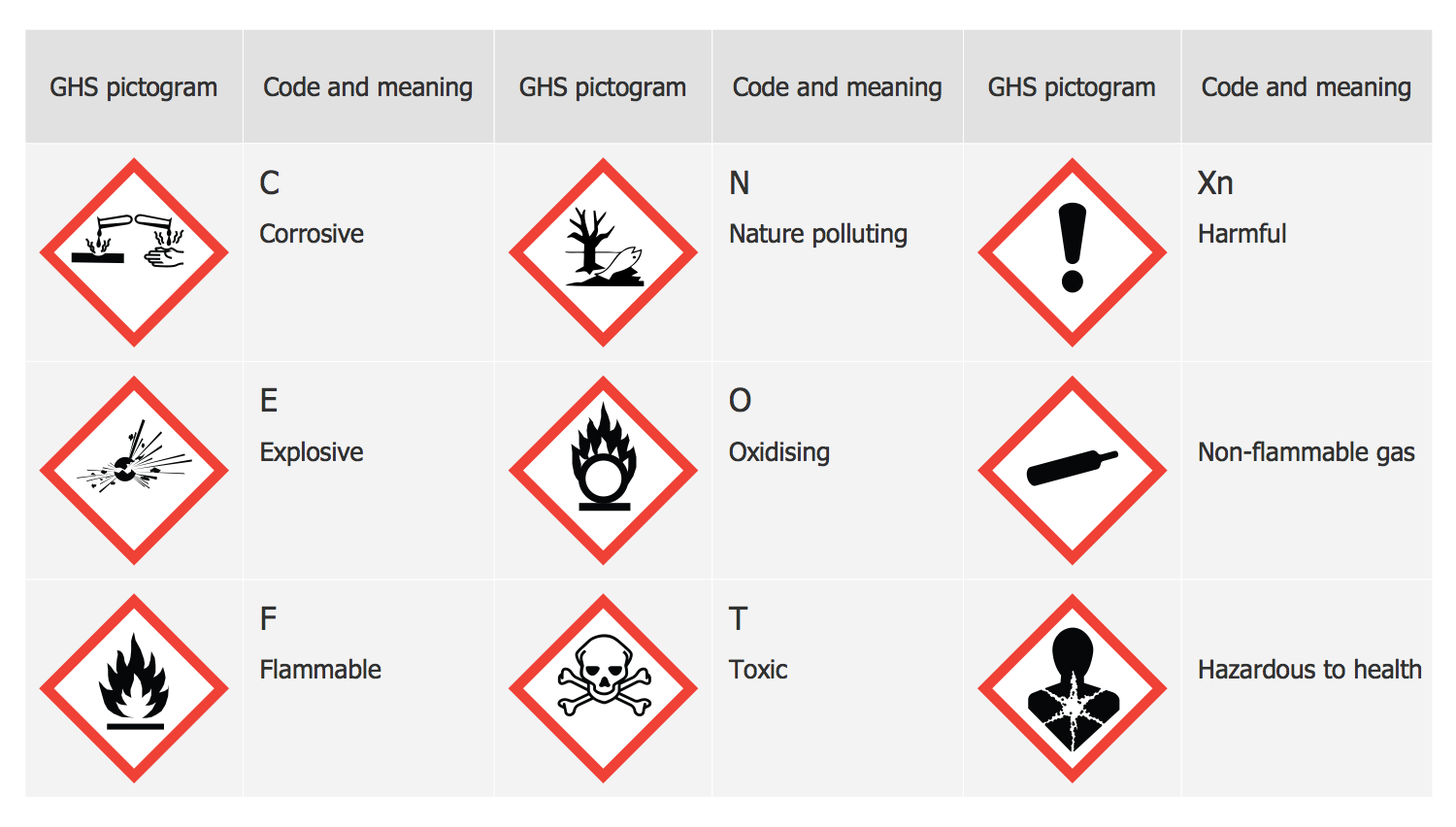
Example 2: GHS HAZCOM Safety Labels — OSHA HAZCOM Standard
This diagram was created in ConceptDraw DIAGRAM using the GHS Hazard Pictograms library from the GHS Hazard Pictograms Solution. An experienced user spent 2 minutes creating this sample.
This example depicts a poster illustrating the whole set of standard GHS chemical hazard pictograms, which are standardized by Globally Harmonized System of Classification and Labeling of Chemicals. Easily create your own hazard illustrations and warning messages in ConceptDraw DIAGRAM.
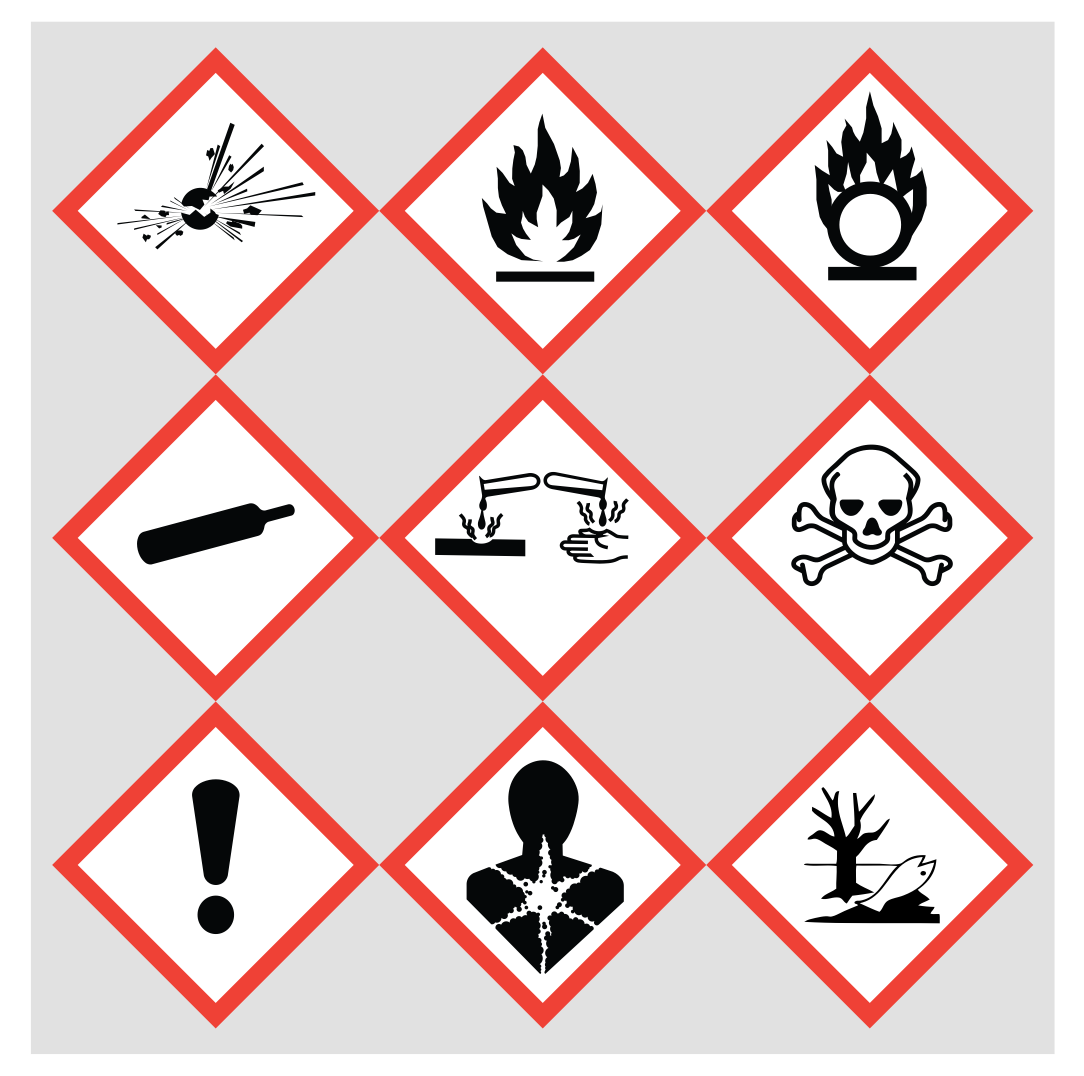
Example 3: Chromium Trioxide Hazards
This diagram was created in ConceptDraw DIAGRAM using the GHS Hazard Pictograms library from the GHS Hazard Pictograms Solution. An experienced user spent 10 minutes creating this sample.
This chemical safety infographic designed with GHS hazard pictograms represents an infobox about the chromium trioxide hazards, which is acid chromic anhydride. The diagram is constructed based on the table from the Wikipedia article "Chromium trioxide". Chromium trioxide is an inorganic compound with CrO3 formula, which dissolves in water together with hydrolysis and has a specific feature for changing its color upon contact with water. Being dark-purple solid under anhydrous conditions, it becomes bright orange in contact with water. Chromium trioxide is a powerful oxidizer, which finds its application mainly in electroplating and chrome plating, but is a suspected carcinogen. As a rule, it is employed with additives, which affect the plating process but don't react with it. Chromium trioxide is produced by treating sodium chromate or the corresponding sodium dichromate with sulfuric acid. Approximately 100,000 tonnes of this compound are produced annually for this goal.
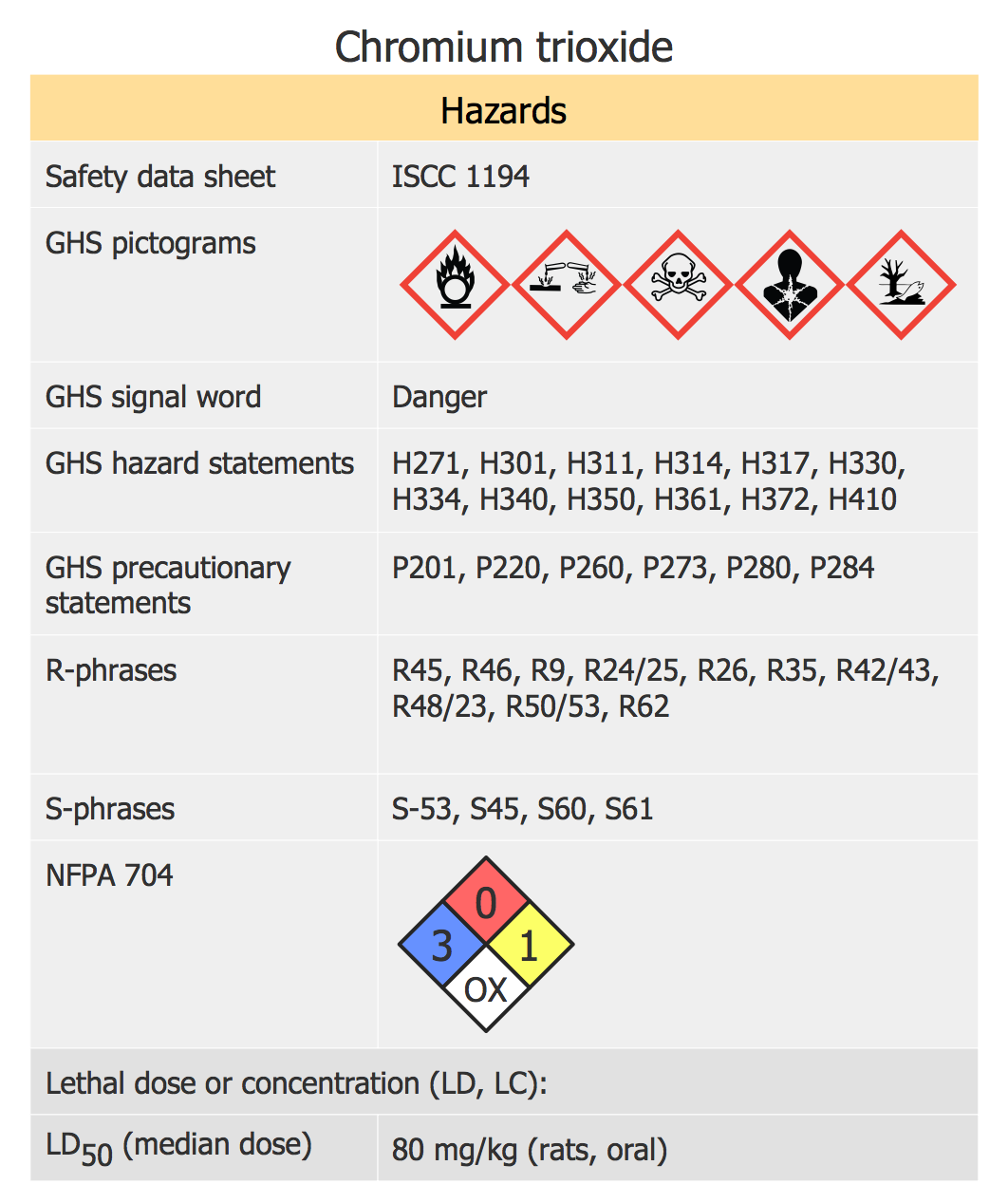
Example 4: GHS Hazard Pictograms — Acetato di etile
This diagram was created in ConceptDraw DIAGRAM using the GHS Hazard Pictograms library from the GHS Hazard Pictograms Solution. An experienced user spent 5 minutes creating this sample.
This example narrates about the danger of ethyl acetate, which is the ester of ethanol and acetic acid. It includes the Hazard statements that indicate the type of hazard compounds and the codes of Precautionary statements for this compound, which are specified on the safety data sheet for chemicals with descriptions and recommendations for preventing and providing first aid in case of danger from this substance.
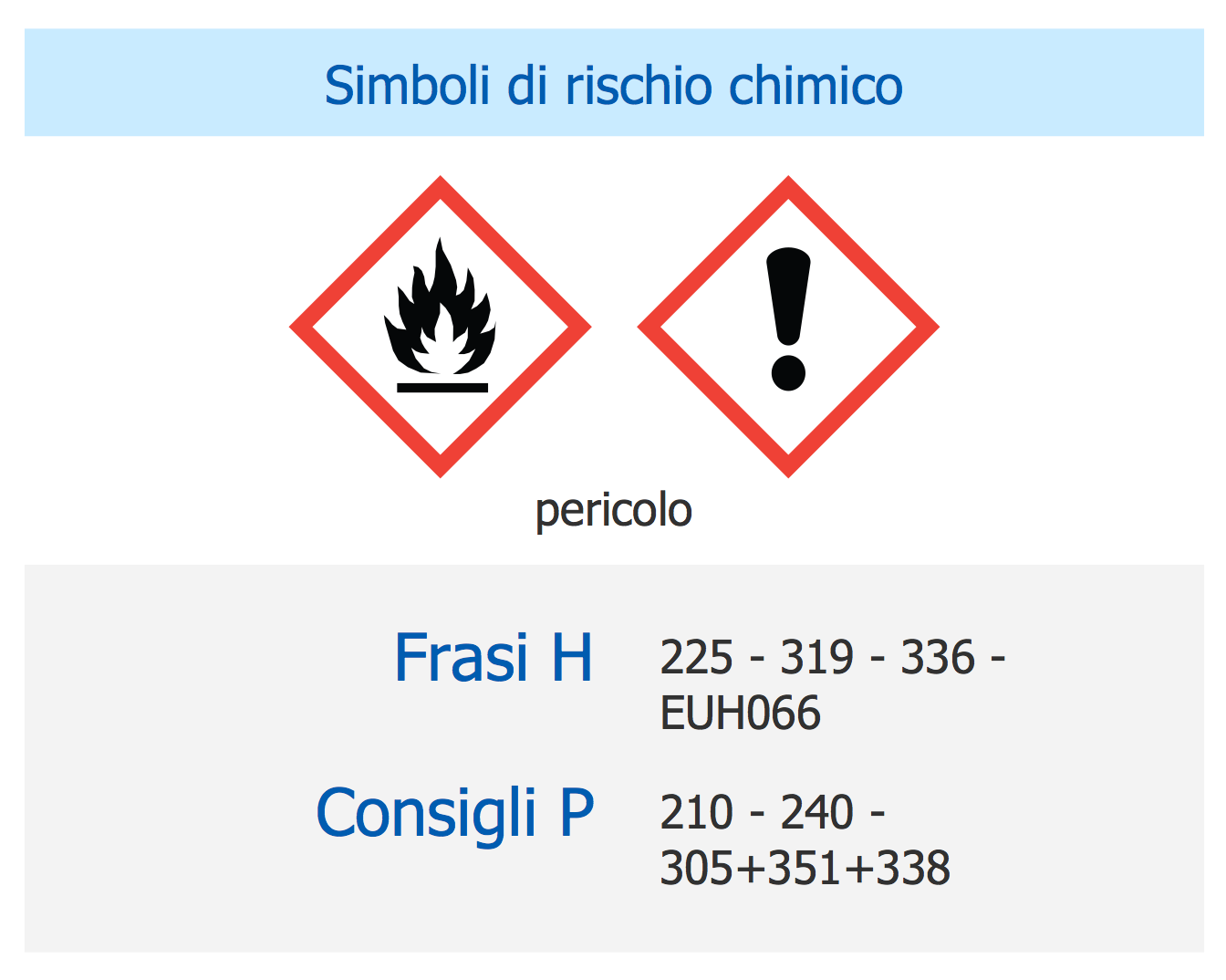
Example 5: Diethylzink
This diagram was created in ConceptDraw DIAGRAM using the GHS Hazard Pictograms library from the GHS Hazard Pictograms Solution. An experienced user spent 10 minutes creating this sample.
This example focuses on the GHS label requirements for diethylzinc or DEZ, which is a colorless liquid. Diethylzinc is a pyrophoric organozinc compound and consists of a zinc center that is bonded to two ethyl groups.
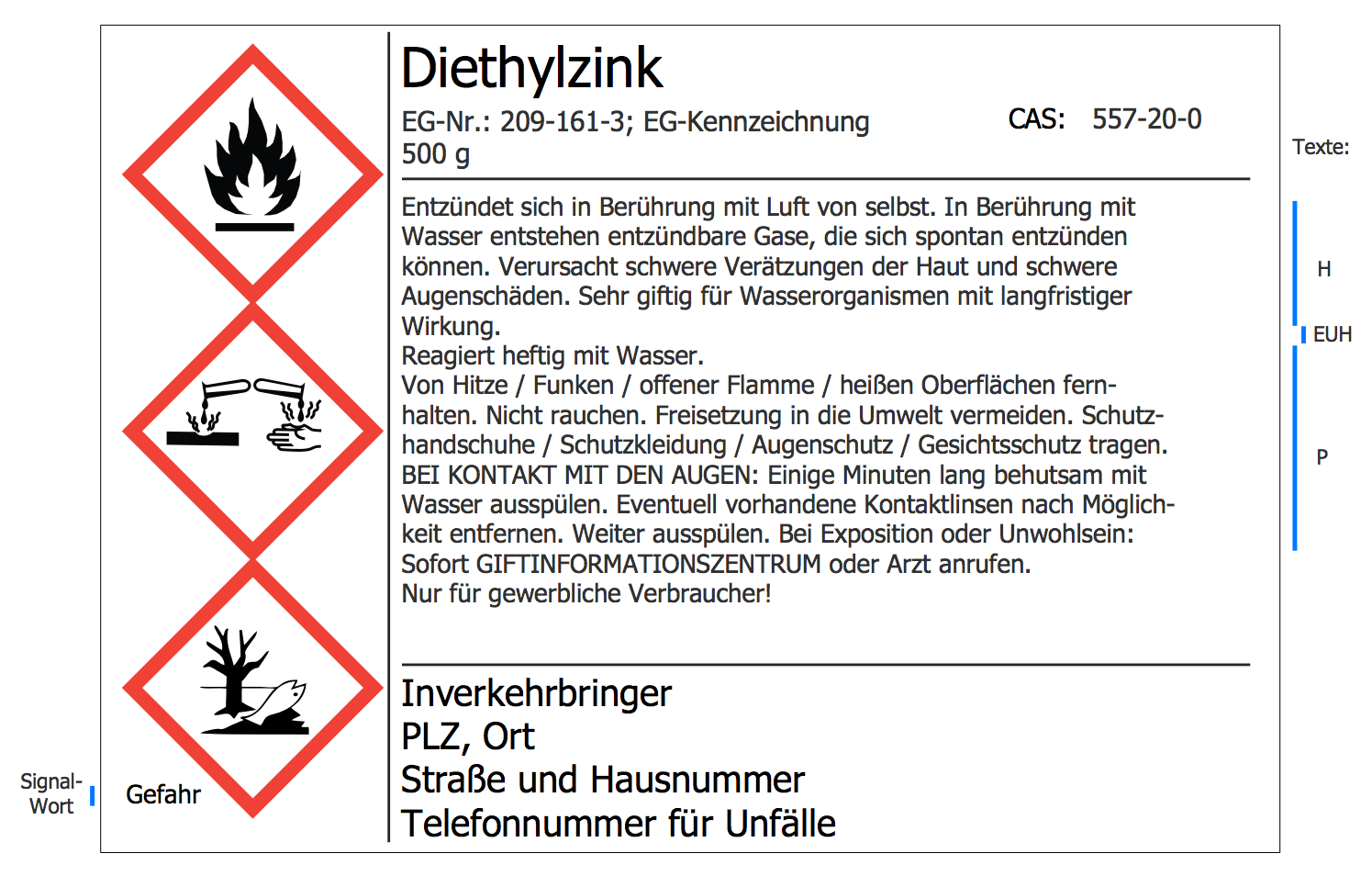
Inside

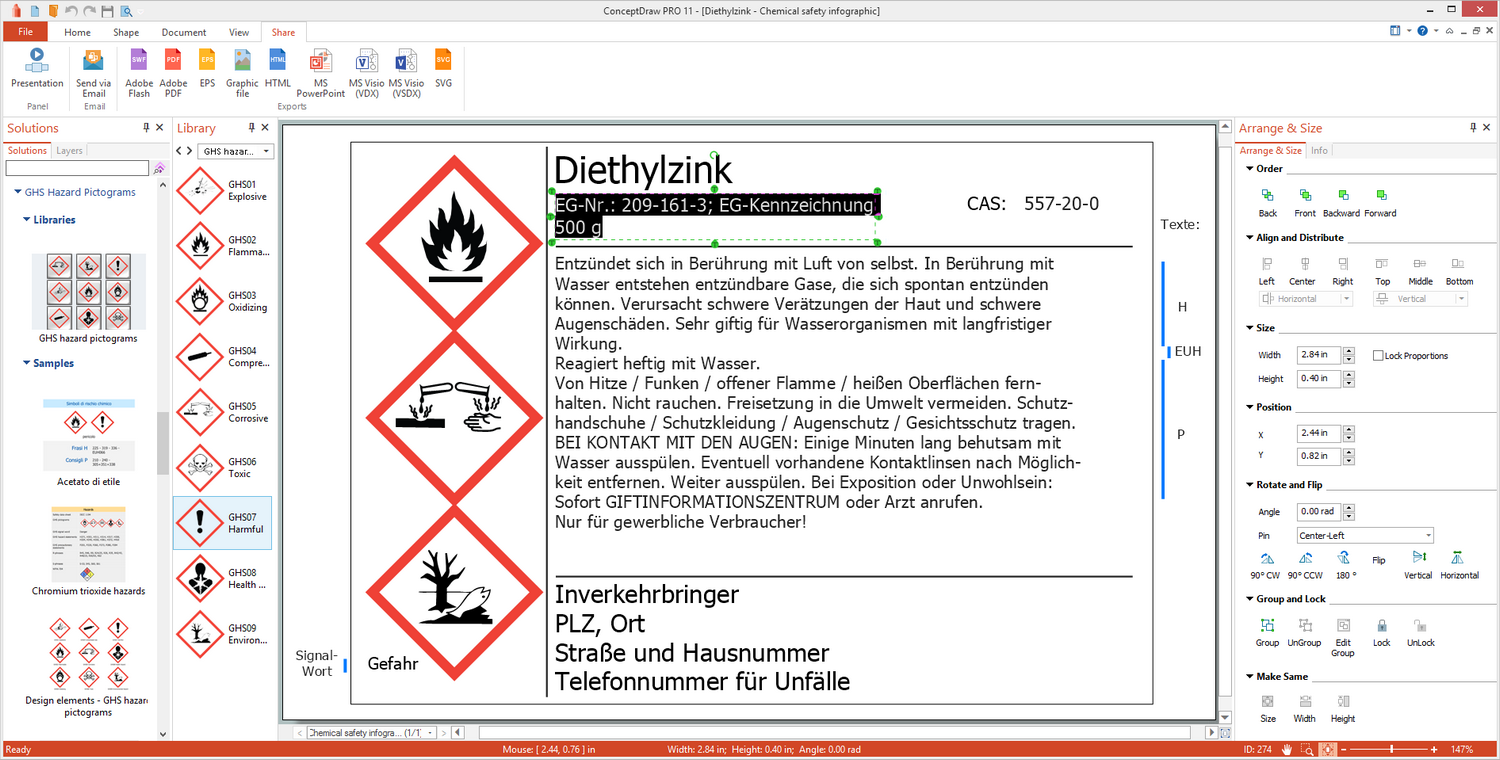
What I Need to Get Started
Both ConceptDraw DIAGRAM diagramming and drawing software and the GHS Hazard Pictograms solution can help creating the illustrations the technical documentation of an engineering projects you need. The GHS Hazard Pictograms solution can be found in the Industrial Engineering area of ConceptDraw STORE application that can be downloaded from this site. Make sure that both ConceptDraw DIAGRAM and ConceptDraw STORE applications are installed on your computer before you get started.
How to install
After ConceptDraw STORE and ConceptDraw DIAGRAM are downloaded and installed, you can install the GHS Hazard Pictograms solution from the ConceptDraw STORE.
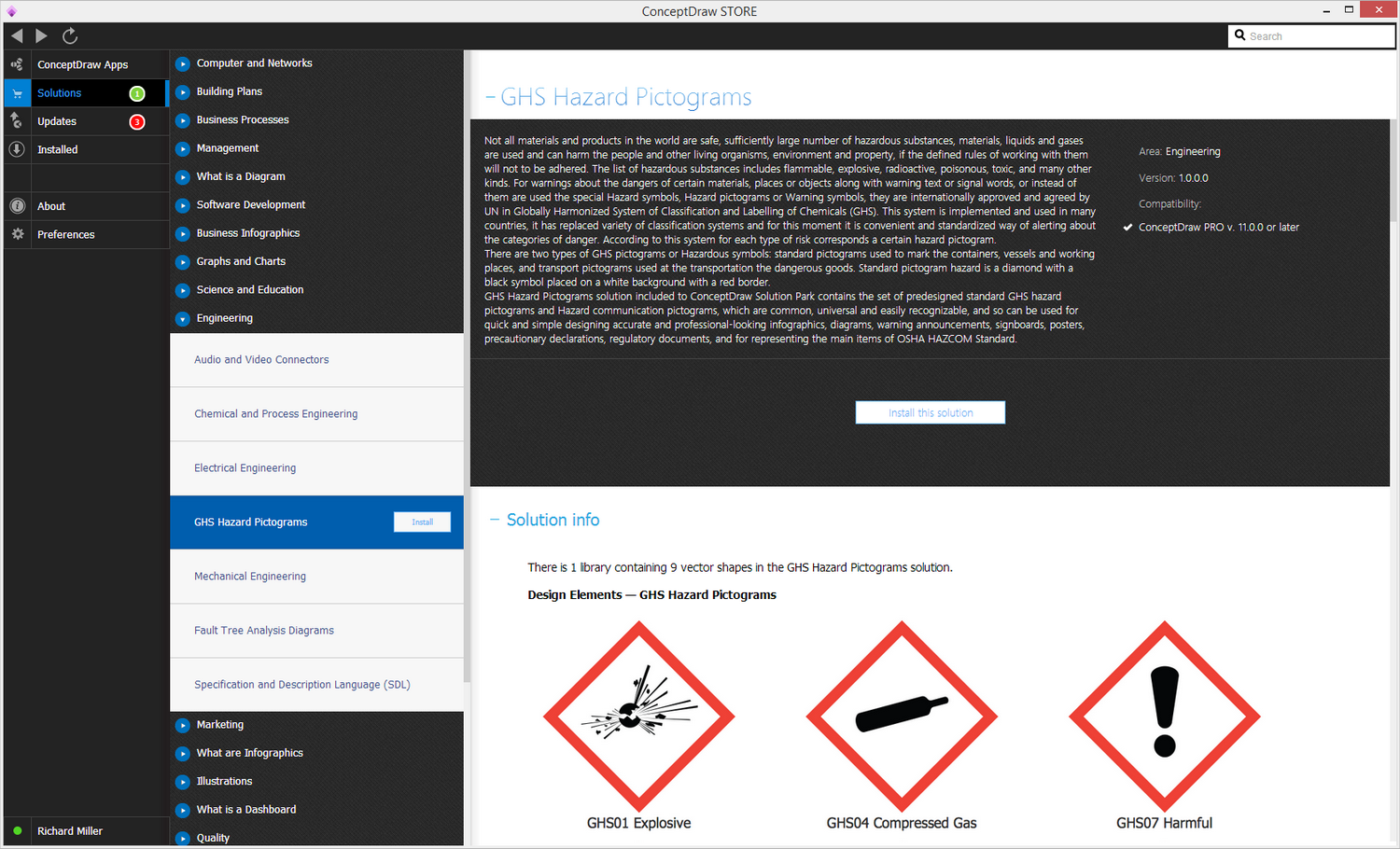
Start Using
To make sure that you are doing it all right, use the pre-designed symbols from the stencil libraries from the solution to make your drawings look smart and professional. Also, the pre-made examples from this solution can be used as drafts so your own drawings can be based on them. Using the samples, you can always change their structures, colors and data.
